Last Updated on July 12, 2025
Shoe Model (Click to scroll to review) | Type | Features | Price |
Running shoes | Surprisingly supportive and versatile for both daily mileage and casual wear. | ||
Running shoes | Built for maximum cushioning, stability, and support, | ||
Running shoes | Plush cushioning with soft heel support that eases plantar fascia strain. | ||
Sandals | Firm orthotic footbed with strong arch support for all-day heel relief. | ||
Sandals | Contoured cork-latex footbed supports arches and reduces heel pressure. | ||
Running shoes | Soft FF Blast+ cushioning and rearfoot gel absorb impact for heel comfort. | ||
Running shoes | Balanced cushioning with smooth transitions and firm heel structure for support. | ||
Running shoes | Dual-density midsole offers arch stability and moderate heel softness. | ||
Dress shoes | Firm rocker sole and arch support reduce heel stress and foot fatigue. |
Plantar fasciitis can be a real impediment to living your life. Thankfully, this chronic foot pain is often the result of inappropriate footwear. So, when you fix your kicks, you fix your symptoms!
Running long miles and working on your feet all day are always stressful, but manageable with the right footwear.
If you buy shoes that properly support your arch, toe, and heel areas like our top picks here, you’re much less likely to run into trouble! We’ve done the research, and found the best ones for you and your feet. We have great options for running shoes, sneakers, dress shoes, and insoles.
Check out our top choices for the best shoes below and for more info on plantar fasciitis, click here.
Best Shoes for Plantar Fasciitis (Sneaker Reviews)
Nike Zoom Pegasus 41

The Nike Pegasus 41 is the latest iteration of Nike’s iconic neutral running shoe—and while it’s not a medical shoe, many runners and walkers with plantar fasciitis find it surprisingly supportive and versatile for both daily mileage and casual wear.
The biggest update in the Pegasus 41 is the switch to ReactX foam, which replaces the older React midsole. This new compound is designed to deliver 13% more energy return while being more sustainable—producing 43% less carbon in the process. It offers a slightly softer and bouncier ride, which is great news for anyone seeking more shock absorption to ease heel or arch pain.
The shoe also retains its signature dual Zoom Air units—one in the forefoot and one in the heel—for a snappy, responsive transition from heel strike to toe-off. For those dealing with plantar fasciitis, that extra bit of cushion in the heel can make a noticeable difference.
While the Pegasus 41 is a neutral shoe, it offers enough structure and balance underfoot to support mild overpronators or those with occasional arch collapse. The updated engineered mesh upper is lighter and more breathable, but still offers enough hold through the midfoot to prevent excess movement.
Users with plantar fasciitis say the shoe provides a soft-yet-responsive underfoot feel, ideal for everything from walking the dog to speed workouts. It also works well for standing all day, thanks to the new foam’s added comfort and energy return.
Fit tip: The Pegasus 41 runs true to size for most wearers. The toe box has a slightly roomier feel than in some past versions, and the padded heel collar prevents slippage without creating pressure.
Men’s version | Women’s version
Asics Gel-Kayano 32

The Gel-Kayano is ASICS’ best-selling running shoe, often called “The Cadillac of Running Shoes”—and for good reason. It’s built for maximum cushioning, stability, and support, making it a go-to choice for runners who need extra protection from impact.
Designed specifically for overpronators, the Kayano 31 smooths out every step, absorbing shock and reducing strain on your feet and joints. It’s like riding in a luxury car—soft, stable, and built for long-distance comfort.
The cushioned midsole features ASICS’ signature GEL technology, offering plush support at a fraction of the weight of traditional rubber cushioning. This means you get impact protection without added bulk, making each run feel light and springy—almost like running on clouds.
The FluidFit upper combines breathable mesh with flexible reinforcements, delivering a sock-like fit that adapts to your foot for secure, all-day comfort. Reviewers often compare it to Nike’s Pegasus, but with even more support and structure.
Many runners find the Gel-Kayano 31 to be a game-changer for plantar fasciitis, joint pain, and heel discomfort, thanks to its high-cushion insole and supportive arch design. It sits a bit higher than models like the Nike Air Pegasus or Brooks Glycerin, making it a top pick for those with heel pain or stability needs.
If you’re looking for a premium stability shoe that delivers comfort, durability, and injury prevention, the Gel-Kayano 31 is a standout choice!
See also: Asics Gel-Kayano 31 Review
Men’s version | Women’s version
Brooks Glycerin 22

The Brooks Glycerin 22 is the latest evolution in the brand’s ultra-cushioned lineup, now featuring nitrogen-infused DNA Loft v3 foam—engineered to deliver a softer, more responsive ride without adding extra weight.
This version is built for neutral runners with medium to high arches, offering maximum cushioning without stability features. The midsole uses dual-size nitrogen-injected cells to enhance impact absorption in the heel and energy return at toe-off. It’s especially comfortable for high-mileage runners and those who need dependable daily trainers with a plush feel.
A major upgrade is the engineered double jacquard mesh upper, which improves breathability while offering a secure yet flexible fit. Reinforced zones around the toe and midfoot provide subtle structure without restricting natural movement.
The redesigned outsole creates smoother transitions and better pressure distribution, helping reduce strain on high-impact areas like the heel and forefoot. While not specifically marketed for plantar fasciitis, the deep cushioning and wide platform make the Glycerin 22 a solid option for those seeking foot stress relief.
Specs:
- Weight: ~10.2 oz (men), ~9.1 oz (women)
- Heel-to-toe drop: 10mm
- Support level: Neutral
- Arch type: Medium to high
Runners say the Glycerin 22 fits true to size and feels more flexible and cushioned than earlier versions. If you liked the Glycerin 20 or 21, expect an even smoother ride with this release.
Best Sandals for Plantar Fasciitis
Here are selection of the best sandals for plantar fasciitis:
Vionic Tide Sandal
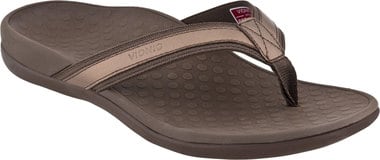
The Vionic Tide Sandal is a top choice for plantar fasciitis sufferers looking for warm-weather relief without sacrificing support. These sandals feature a podiatrist-designed footbed with a deep heel cup that helps cradle the heel, improve alignment, and reduce overpronation—key factors in easing plantar fasciitis pain.
They also offer strong arch support and a lightweight EVA midsole that runs the full length of the foot. This cushioning helps absorb shock and reduces stress on your feet, ankles, and knees as you walk.
The durable rubber outsole provides reliable traction on both dry and wet surfaces, making them great for everyday wear, beach walks, or errands.
One standout feature? The Vionic Tide Sandal is one of the few sandals awarded the American Podiatric Medical Association (APMA) Seal of Acceptance—signifying they’re clinically recognized as beneficial for foot health, including plantar fasciitis.
You will notice improvement in heel pain after just a few days of wear, especially once your feet have adjusted to the orthotic design.
Birkenstock Arizona Sandals
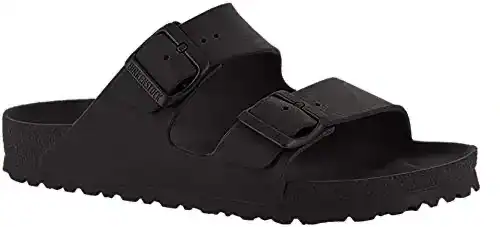
Birkenstock’s Arizona sandals are by far our favorites for healthy feet! Not only do they resolved P.F. symptoms like nothing we’ve ever tried, but they make for a healthier gait and happier joints!
Their supportive footbed is far more therapeutic than any flip flop. While Birk’s used to be a “hippie” style, they’re now totally in fashion.
As more and more folks discover their comfort credentials, we want to encourage anyone who’s passed them by to give them another look!
These are pricey sandals, but we think they’re more than worth the cost. Birkenstock’s have natural cork and latex footbeds which are sculpted to provide the healthiest possible walk.
They have strong arch support, and a deep heel cup to return weight distribution to its natural alignment.
The metatarsal ridge encourages foot muscle engagement like you have when you’re walking barefoot in sand!
Best of all, the natural materials shape to your feet as you break them in. Unlike EVA, which simply softens, they reshape while retaining springiness and structure.
We’re recommending the softer variety, since they’re easier to get into when you’re new to Birk’s. There’s much less of a break-in period than the standard versions.
Learn more about why Birkenstock’s are our go-to kicks for problem feet in our guide to the best sandals for P.F.!
Best Running Shoes for Plantar Fasciitis
Here are the best running shoes for plantar fasciitis.
Asics Gel Nimbus 27
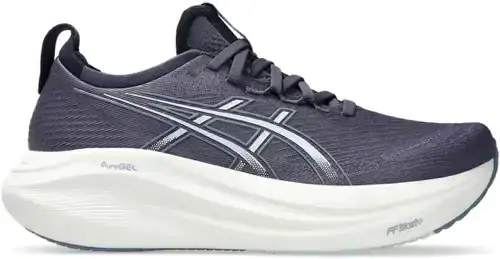
The ASICS Gel-Nimbus 27 is the latest evolution of one of ASICS’ most popular neutral running shoes—and it continues to be an excellent choice for people dealing with plantar fasciitis. It’s designed for runners and walkers who want cloud-like cushioning without sacrificing performance.
This version features a full-length FF BLAST™ PLUS ECO midsole, offering even softer landings and a smoother ride than previous models. It’s made with at least 20% bio-based content, combining sustainability with comfort.
The PureGEL™ technology, now even more discreetly integrated into the heel, absorbs impact during footstrike—one of the most crucial features for alleviating plantar fasciitis pain. This helps reduce heel pressure and contributes to more fluid transitions throughout your gait cycle.
The upper has been redesigned with a soft, engineered knit for a flexible, breathable fit that hugs the foot without causing pressure points.
Reviewers consistently praise the Gel-Nimbus 27 for its all-day wearability, saying it’s a great option not just for long runs, but also for work, travel, and recovery. Many users dealing with plantar fasciitis note reduced heel pain and less fatigue after switching to this model.
If you’re seeking a plush, supportive shoe that still feels light and responsive, the Gel-Nimbus 27 delivers comfort where it counts.
Men’s version | Women’s version
Brooks Ghost 17
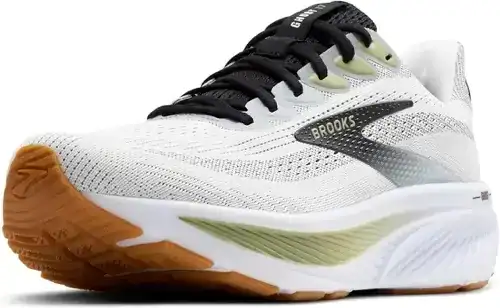
The Brooks Ghost 17 remains a go-to daily trainer for runners and walkers dealing with plantar fasciitis. Though technically a neutral shoe, its stable ride and soft yet responsive cushioning offer support that appeals to both neutral foot types and mild overpronators seeking all-day comfort and pain relief.
This newest model introduces DNA LOFT v3 cushioning throughout the entire midsole. This nitrogen-infused foam is Brooks’ softest and most advanced yet, delivering plush impact protection without added weight—key for reducing pressure on inflamed heels and tender arches.
The Ghost 17 provides moderate arch support, a plush padded heel collar, and retains its 12mm heel-to-toe drop, which subtly shifts weight forward—helpful for easing strain on the plantar fascia. Combined, these features offer a forgiving ride for those suffering from chronic heel pain or early-stage plantar fasciitis.
Compared to more structured stability models like the Brooks Glycerin GTS, the Ghost 17 is lighter and more flexible, making it better suited for both easy runs and extended walking or standing sessions. Weighing around 9.8 oz for men and 8.6 oz for women, it balances cushion with agility better than many shoes in its class.
Other comfort-focused features include a breathable engineered air mesh upper, padded tongue and collar, and a smooth-fitting soft liner that reduces hot spots and irritation. The segmented crash pad adapts to your unique gait, promoting smoother transitions and reducing jarring impact, while blown rubber in the forefoot improves durability and traction.
The removable insole makes it easy to insert custom orthotics, a key consideration for plantar fasciitis sufferers. The shoe is also part of Brooks’ sustainability initiative: the Ghost 17 is carbon neutral and constructed with recycled materials in the upper.
Coach’s tip: Most wearers find the Ghost 17 runs true to size. However, if you’re between sizes or plan to add a thicker insole, consider going half a size up for the best fit.
Men’s version | Women’s version
Adidas Supernova 2
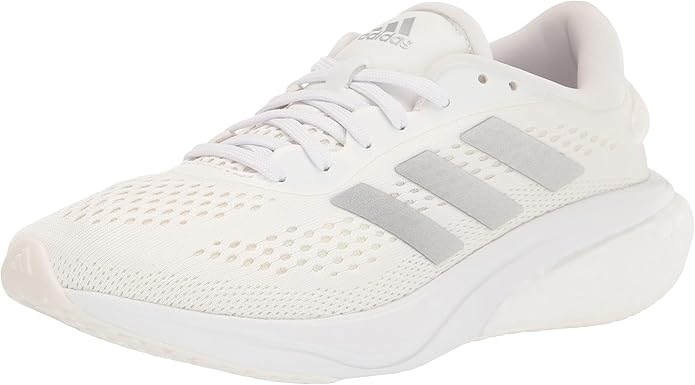
This pair from Adidas features the company’s Boost foam. It’s designed to return energy back to you as you run. We’ve found it makes a real difference in helping you push off with each step.
The footbed is supported by a full-length EVA frame, which provides stability for pronators. There’s also a Torsion system to correct mid-foot rotation.
All of this is topped by a sock-fit mesh upper, designed to keep your foot lined up with the support features as you run.
They’re very comfortable straight out of the box. We also found these to be ideal for workouts at the gym!
Dansko Women’s Professional Patent Clog
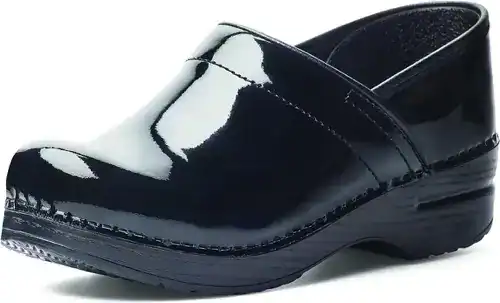
The Dansko Women’s Professional Patent Clog offers substantial relief for individuals suffering from plantar fasciitis. Built with a contoured midsole and strong arch support, the clog helps distribute weight evenly across the foot, easing tension on the plantar fascia. The rocker bottom design promotes a natural gait and reduces impact on the heel, which is especially important for managing heel pain. The firm construction prevents foot collapse, while the padded instep and roomy toe box add comfort without compromising support. Many users with plantar fasciitis report significant pain reduction after a few days of wear, particularly in work environments that require prolonged standing.
The patent leather upper is stylish and easy to clean, though it can feel stiff at first and may take some breaking in. It’s worth noting that the high heel and rigid sole may not suit everyone, especially those who prefer more flexibility. Overall, for those seeking a dependable, supportive shoe that targets plantar fasciitis discomfort during long workdays, the Dansko Professional Patent Clog remains a top contender.
Pairing it with a cushioned plantar fasciitis sock or orthotic insert can further enhance comfort and relief. Available in a wide range of sizes and colors, it’s both a functional and fashionable choice.
Plantar Fasciitis 101
Plantar fasciitis is a condition which plagues people around the world. According to Wikipedia, it affects about 10% of people during their lifetime!
You might not know it by name, but you almost certainly know someone who’s experienced the condition.
So, what exactly is P.F.?
Plantar fasciitis occurs when the plantar fascia (the muscle tissue connecting your heel to your toes) gets stressed out. This muscle can stretch and eventually develop small tears, which can be extremely painful.
Symptoms for plantar fasciitis are generally felt along the arch or in the heel. Anywhere the muscle runs, you could experience twinges, spasms, and aches.
Symptoms can surface differently depending on the person. You might feel stiffness at first, and need more time to warm up in the morning.
Eventually, though, if you don’t do anything to resolve it, you’ll probably start to feel sharp pains in the heel and/or arch.
Several factors can contribute to plantar fasciitis. The first one is a change in routine. If you start running for the first time without easing into it, or start a new job that involves walking around all day, your feet won’t have a chance to adjust.
The main muscle then gets overworked, and lets you know about it!
Even if running and walking a lot is something you’ve done for a long time, you’re still at risk for plantar fasciitis if you don’t stretch and strengthen regularly.
Despite the fact that you won’t be posting pictures of it on social media, your plantar fascia needs just as much upkeep as those abs you’re proud of.
Without a decent amount of foot-strengthening exercises in your life, you’re asking for a visit from the P.F. poltergeist. That’s why lunges and toe-raises are so helpful.
Your foot type also plays a role. If you have a flat/fallen arch or a high arch, you’re more likely to have foot problems like PF.
That brings us neatly to the last and most important factor–your footwear! Wearing unsupportive shoes is a recipe for P.F. pain. Your arch needs support, or it’ll get overworked and strained.
To prevent and/or alleviate this condition, you’ll want to find a pair that provides you with more pronounced arch support.
And remember, while shoes are an important step in your journey to pain-free walking and running, you’ll also have to stretch, rest, and exercise carefully.
How To Choose Footwear That Will Actually Relieve Pain
Here are some key factors to consider when shopping for the best shoes:
Support
The key to finding the best shoes for heel pain relief is proper arch support. The level of arch support you need depends on your foot type.
For example, if you’ve got a very high arch, you’ll need a more severe arch support. Otherwise, your arch will have to stretch out every time you take a step, which will cause soreness.
Get to know your foot type before you shop. If you’ve got a high or low arch, your feet probably have some amount of pronation (side to side movement) as you walk or run.
If it’s prominent, you might want to find footwear with a bit more stability built in. Generally, that will be around the midsole and heel. You’ll also want a fair amount of cushion.
The more impact your footwear absorbs, the less impact your arch needs to handle. And, of course, you’ll want a cushioned, stable heel.
Remember to look for similar support features in all your shoes. The features that make the best dress shoes will be the same arch support, heel cupping, and enhanced cushioning that define the best tennis shoes for plantar fasciitis.
Style
Plantar fasciitis doesn’t need to interfere with your style! As you can see, we found plenty of options that look great but still support your feet properly.
However, you should expect the soles to be a bit thicker. Remember that comfort is the most important priority.
And if you need sleek, sophisticated shoes for work, you can use orthotic insoles to make them more functional!
Budget
It’s always a good idea to spend a little more for a well-made shoe. If you have plantar fasciitis, you know that cheaply made or poorly designed footwear is asking for trouble. Plus, you want your shoes to last.
It’s a safe bet to buy a shoe from a well-known footwear brand. They’ll have put more money and effort into designing their shoes, and their shoes will have a lot more reviewer feedback.
However, the best shoes for plantar fasciitis shouldn’t be much more expensive than any other high-quality footwear. Our top picks have a range of prices, and none of them will break the bank.
Other Helpful Hints
While finding a good pair of kicks is the best thing you can do to improve foot health, we know that P.F. symptoms can be very painful.
They often last for weeks, and they won’t be resolved overnight. So, while you’re waiting for your feet to adjust, try this simple exercise:
Your pain symptoms are most likely in your heel, but to relieve the plantar fascia, you should massage the arch of your foot.
Use a firm ball as shown above, and rock around to massage the arch of your foot. That will help loosen up the tissue and relieve some of the pain!